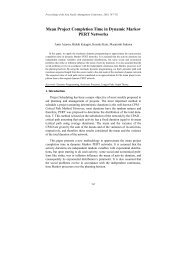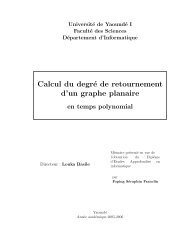Models for Global Constraint Applications - Cork Constraint ...
Models for Global Constraint Applications - Cork Constraint ...
Models for Global Constraint Applications - Cork Constraint ...
Create successful ePaper yourself
Turn your PDF publications into a flip-book with our unique Google optimized e-Paper software.
y5 {1,3}<br />
y4 {1,2}<br />
y3 1..4<br />
y2 1..4<br />
y1 1..4<br />
a b c d e<br />
Figure 1: Example Problem<br />
between y1, y2 and y3 is handled both at time point d and e. This redundant<br />
expression is acceptable when compared to the increase of propagation this<br />
model allows.<br />
For the alldifferent constraint we can choose between different propagation<br />
algorithms with varying reasoning power and computational complexity [69].<br />
Which selection will be more successful will depend on the particular problem<br />
instance. If the domains are very sparse and vary significantly between planes,<br />
then a hyper-arc consistent version may provide more propagation, which offsets<br />
its higher complexity. If domains are large and quite similar, then a fast, boundconsistent<br />
implementation will be more effective.<br />
But even if we use hyper-arc consistency <strong>for</strong> the alldifferent constraints,<br />
there are some domain reductions we can’t per<strong>for</strong>m since we do not consider<br />
the interaction of multiple constraints. We again use figure 1 as an example.<br />
Planes y4 and y5 must be assigned the same value, in this case 1, as it is the<br />
only common value in their domains. But en<strong>for</strong>cing hyper-arc consistency on<br />
sets d and e does not detect this. Figure 2 shows two bipartite matchings <strong>for</strong><br />
the two constraints, but there are no compatible solutions unless both y4 and<br />
y5 are assigned to 1.<br />
2.2.3 Model 3<br />
Our third alternative model of the non-overlap constraint uses the diffn constraint<br />
of CHIP [13]. The constraint expresses that n-dimensional recti-linear<br />
objects do not overlap. We model each parking event as a two dimensional rectangle<br />
with origin at (si, yi), length di and height 1. The non-overlap constraint<br />
then is written as<br />
diffn({〈si, yi, di, 1〉|i ∈ I}) (7)<br />
It is up to the constraint designer to decide whether he wants to use generic<br />
non-overlap reasoning [14], or whether the constraint internally is further specialised<br />
to handle this particular assignment structure of the constraint, where<br />
x-dimension, width and height are constant. It is then possible to transparently<br />
7









